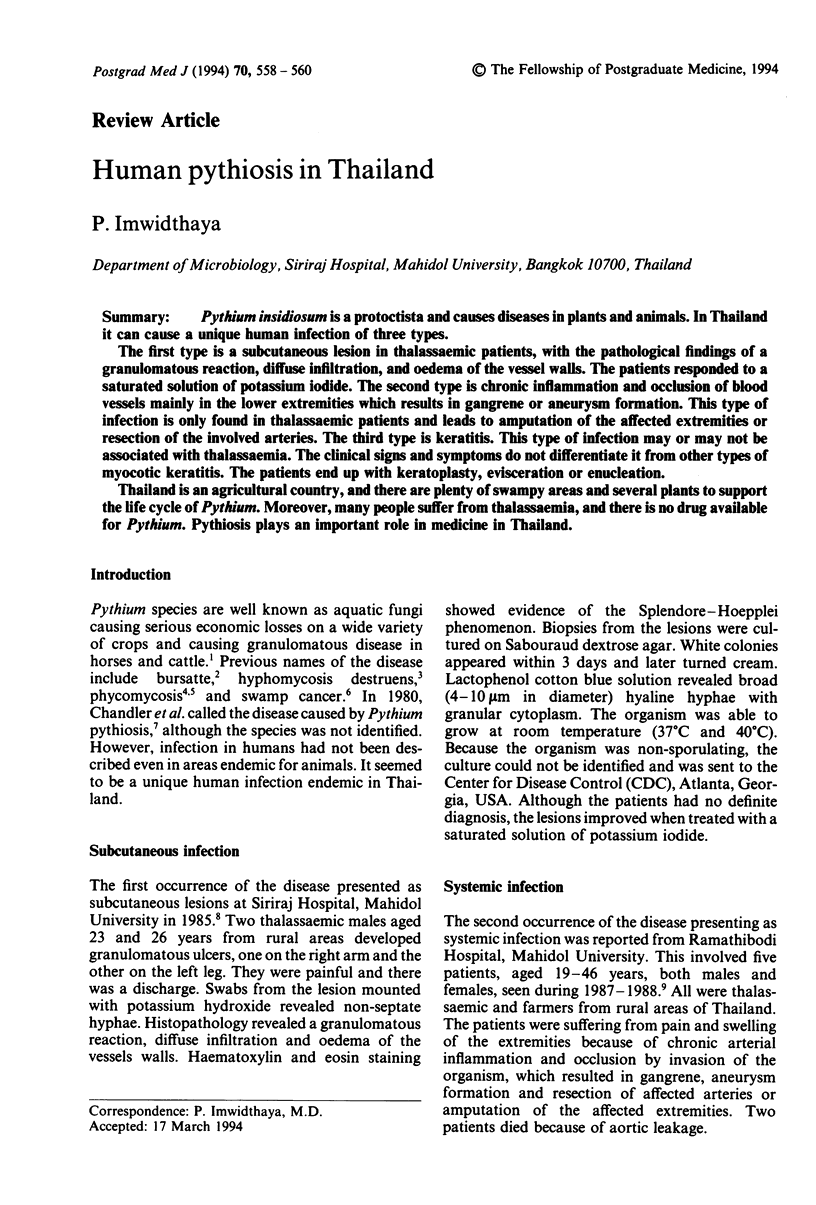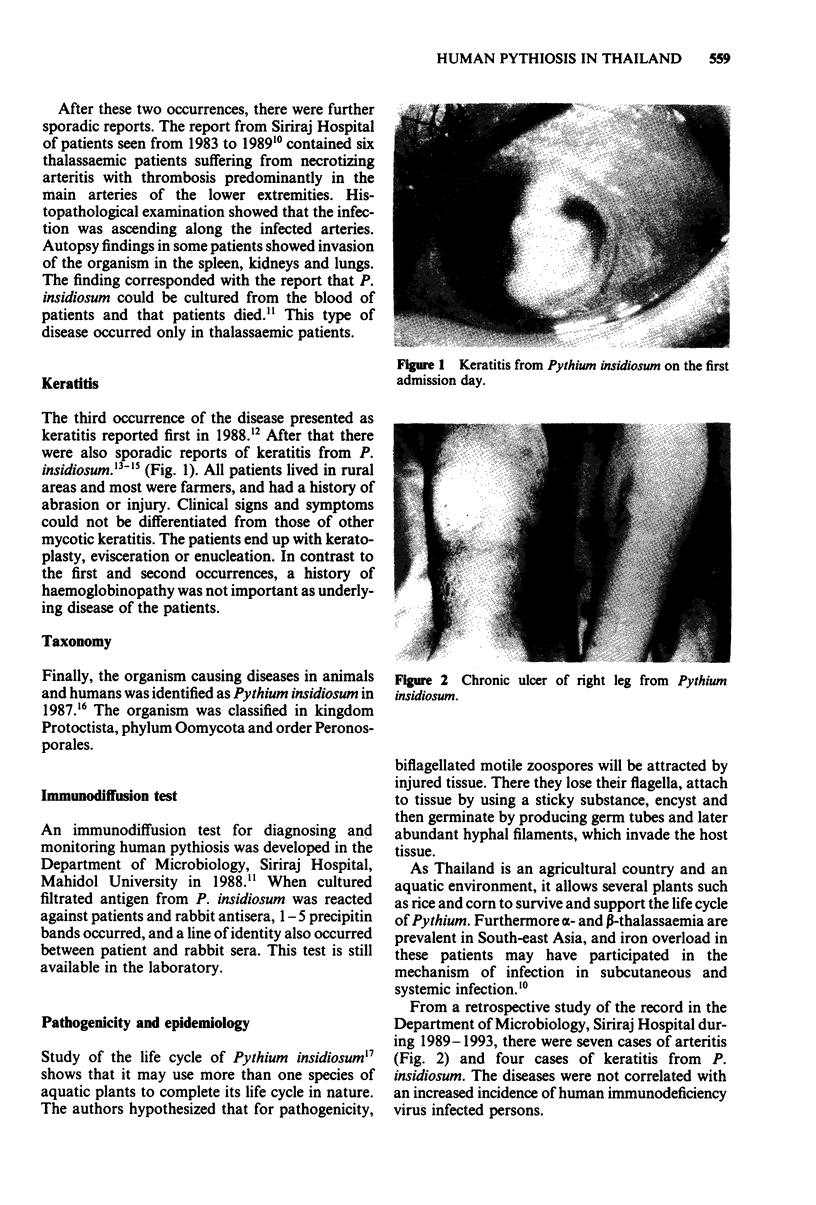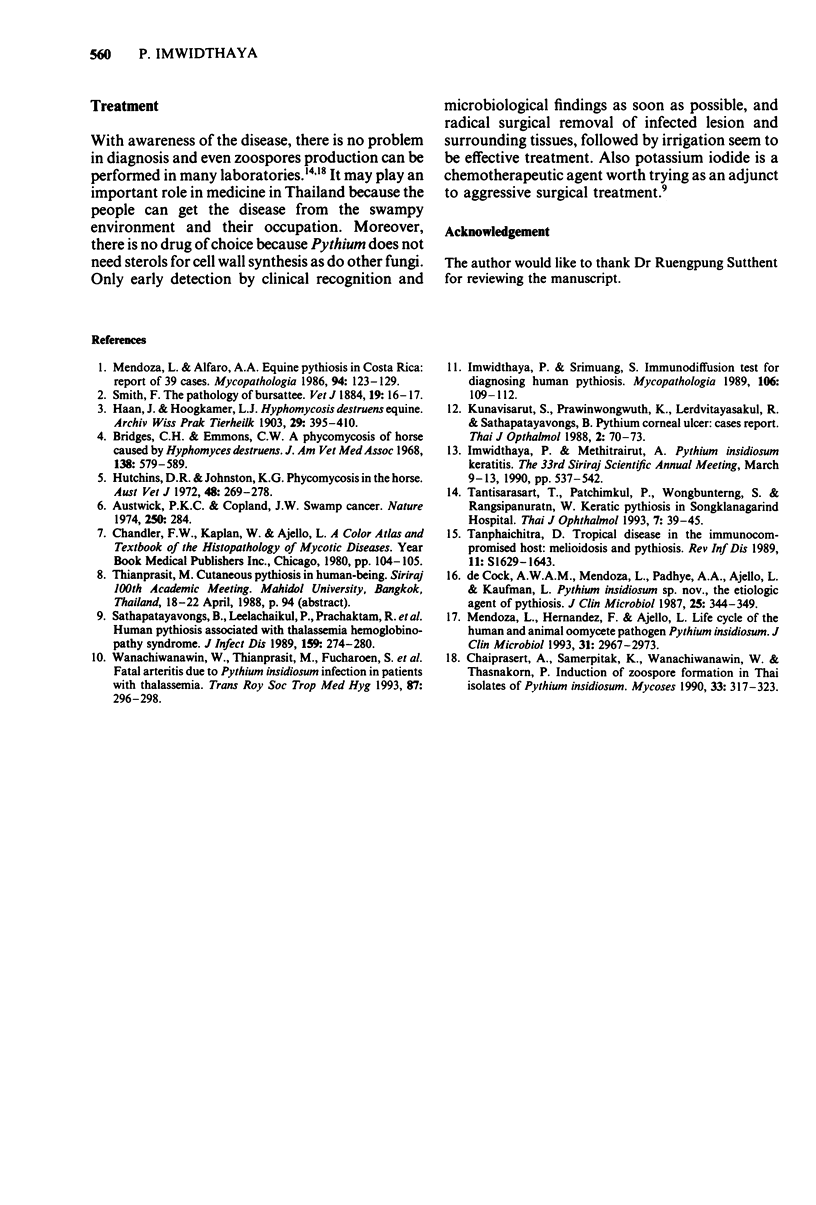Abstract
Pythium insidiosum is a protoctista and causes diseases in plants and animals. In Thailand it can cause a unique human infection of three types. The first type is a subcutaneous lesion in thalassaemic patients, with the pathological findings of a granulomatous reaction, diffuse infiltration, and oedema of the vessel walls. The patients responded to a saturated solution of potassium iodide. The second type is chronic inflammation and occlusion of blood vessels mainly in the lower extremities which results in gangrene or aneurysm formation. This type of infection is only found in thalassaemic patients and leads to amputation of the affected extremities or resection of the involved arteries. The third type is keratitis. This type of infection may or may not be associated with thalassaemia. The clinical signs and symptoms do not differentiate it from other types of myocotic keratitis. The patients end up with keratoplasty, evisceration or enucleation. Thailand is an agricultural country, and there are plenty of swampy areas and several plants to support the life cycle of Pythium. Moreover, many people suffer from thalassaemia, and there is no drug available for Pythium. Pythiosis plays an important role in medicine in Thailand.
Full text
PDF


Images in this article
Selected References
These references are in PubMed. This may not be the complete list of references from this article.
- Chaiprasert A., Samerpitak K., Wanachiwanawin W., Thasnakorn P. Induction of zoospore formation in Thai isolates of Pythium insidiosum. Mycoses. 1990 Jun;33(6):317–323. doi: 10.1111/myc.1990.33.6.317. [DOI] [PubMed] [Google Scholar]
- De Cock A. W., Mendoza L., Padhye A. A., Ajello L., Kaufman L. Pythium insidiosum sp. nov., the etiologic agent of pythiosis. J Clin Microbiol. 1987 Feb;25(2):344–349. doi: 10.1128/jcm.25.2.344-349.1987. [DOI] [PMC free article] [PubMed] [Google Scholar]
- Hutchins D. R., Johnston K. G. Phycomycosis in the horse. Aust Vet J. 1972 May;48(5):269–278. doi: 10.1111/j.1751-0813.1972.tb05155.x. [DOI] [PubMed] [Google Scholar]
- Imwidthaya P., Srimuang S. Immunodiffusion test for diagnosing human pythiosis. Mycopathologia. 1989 May;106(2):109–112. doi: 10.1007/BF00437089. [DOI] [PubMed] [Google Scholar]
- Mendoza L., Alfaro A. A. Equine pythiosis in Costa Rica: report of 39 cases. Mycopathologia. 1986 May;94(2):123–129. doi: 10.1007/BF00437377. [DOI] [PubMed] [Google Scholar]
- Mendoza L., Hernandez F., Ajello L. Life cycle of the human and animal oomycete pathogen Pythium insidiosum. J Clin Microbiol. 1993 Nov;31(11):2967–2973. doi: 10.1128/jcm.31.11.2967-2973.1993. [DOI] [PMC free article] [PubMed] [Google Scholar]
- Sathapatayavongs B., Leelachaikul P., Prachaktam R., Atichartakarn V., Sriphojanart S., Trairatvorakul P., Jirasiritham S., Nontasut S., Eurvilaichit C., Flegel T. Human pythiosis associated with thalassemia hemoglobinopathy syndrome. J Infect Dis. 1989 Feb;159(2):274–280. doi: 10.1093/infdis/159.2.274. [DOI] [PubMed] [Google Scholar]
- Tanphaichitra D. Tropical disease in the immunocompromised host: melioidosis and pythiosis. Rev Infect Dis. 1989 Nov-Dec;11 (Suppl 7):S1629–S1643. doi: 10.1093/clinids/11.supplement_7.s1629. [DOI] [PubMed] [Google Scholar]
- Wanachiwanawin W., Thianprasit M., Fucharoen S., Chaiprasert A., Sudasna N., Ayudhya N., Sirithanaratkul N., Piankijagum A. Fatal arteritis due to Pythium insidiosum infection in patients with thalassaemia. Trans R Soc Trop Med Hyg. 1993 May-Jun;87(3):296–298. doi: 10.1016/0035-9203(93)90135-d. [DOI] [PubMed] [Google Scholar]




